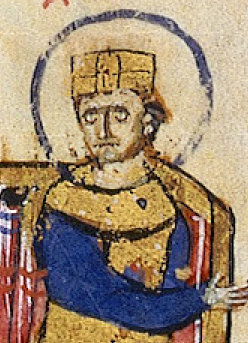
Emperor Leo V the Armenian, born in 775 and departing this life on December 25, 820, stands as a significant yet controversial figure in the annals of Byzantine history. Known predominantly for his revival of Iconoclasm, Leo’s reign marked a turbulent period in the religious and political landscape of the Byzantine Empire. His ascent to the throne and subsequent policies not only shaped the empire’s internal dynamics but also left an indelible mark on its ecclesiastical history.
Ascension to the Throne
Leo V the Armenian’s journey to the Byzantine throne was a testament to his resilience and strategic acumen. Born in Armenia, Leo rose through the military ranks, displaying remarkable leadership and tactical skills. His military career was a crucial factor in his eventual ascension to the throne in 813. This period was characterized by political instability and frequent power struggles, providing Leo with the opportunity to seize control.
The Byzantine Empire, under Leo V’s reign, experienced significant administrative and military reforms. Recognizing the empire’s vulnerabilities, Leo focused on strengthening the military and fortifying defenses, particularly against the Bulgarian threats. His military campaigns and defensive strategies were pivotal in stabilizing the empire during a period of external threats and internal dissent.
Revival of Iconoclasm
Leo V’s reign is most notable for the revival of Iconoclasm, a movement opposing the veneration of religious icons, which had profound implications for the Byzantine Church and society. Upon ascending the throne, Leo initially adopted a moderate stance towards religious practices. However, influenced by various factors, including personal convictions and political calculations, he reinstated the Iconoclastic policies in 815.
The reintroduction of Iconoclasm under Leo V marked a significant shift in the religious landscape of the Byzantine Empire. This policy reversal led to the persecution of iconophiles, the destruction of religious icons, and a deep division within the Byzantine Church. Leo’s staunch enforcement of Iconoclastic policies not only altered the religious practices of the time but also sparked widespread controversy and conflict, both within the empire and with the papacy.
Leo V’s implementation of Iconoclasm was driven by a complex interplay of theological beliefs, political expediency, and the desire to assert imperial control over the church. His policies reflected his belief in the need for a unified religious practice under imperial authority, a stance that significantly impacted the Byzantine Empire’s religious and political realms.
Political and Administrative Reforms
Under Emperor Leo V the Armenian, the Byzantine Empire witnessed significant political and administrative reforms. His reign was marked by a pragmatic approach to governance, focusing on consolidating power and enhancing the efficiency of the administration. Leo reorganized the military structure, introducing new tactics and fortifying the empire’s defenses. His administrative policies, aimed at stabilizing the state’s finances and streamlining bureaucracy, played a crucial role in restoring order and discipline within the empire.
Assassination and Legacy
The reign of Leo V the Armenian ended abruptly with his assassination during a church service on Christmas Day, 820. This violent conclusion to his rule was a direct result of the contentious policies he had implemented, particularly his revival of Iconoclasm. Despite his untimely death, Leo’s legacy continued to influence Byzantine politics and religious affairs. His staunch promotion of Iconoclasm had lasting effects, perpetuating theological debates and shaping the empire’s religious policies for years to come.
Emperor Leo V the Armenian’s reign, characterized by military prowess, administrative reforms, and religious controversy, left a complex legacy in Byzantine history. His efforts to strengthen the empire and his revival of Iconoclasm have been subjects of extensive historical analysis, reflecting the multifaceted nature of his rule.
References
- Kiapidou, Eirini-Sofia. “Leo V the Armenian.” Encyclopedia of the Medieval Chronicle. Brill, 2016. Brill (accessed December 13, 2023).
- Mango, Cyril. “The Oxford History of Byzantium.” Oxford University Press, 2002.
- Ostrogorsky, George. “History of the Byzantine State.” Rutgers University Press, 1969.
- Treadgold, Warren. “A History of the Byzantine State and Society.” Stanford University Press, 1997.
- “Leo V.” Encyclopædia Britannica. Britannica (accessed December 13, 2023).

